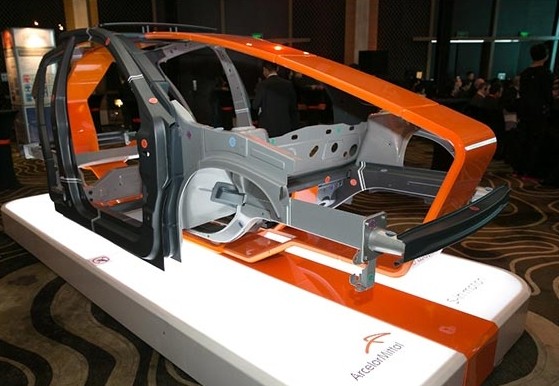

The S-in motion reduces the weight of 43 auto parts in a typical C-class vehicle.
Joint venture helps drive industry forward with its body, powertrain solutions
In addition to improving the powertrain system, lightweight automobile steel can also help vehicles improve energy efficiency without compromising safety, according to Valin ArcelorMittal Automotive Steel Co Ltd.
The company, also known as VAMA, is a 51-49 joint venture between Valin Steel Co Ltd in Hunan and ArcelorMittal, the world's leading integrated steel and mining company with its headquarters in Luxemburg.
VAMA last week debuted its lightweight automotive project "S-in motion" in China - a series of solutions to optimize the body weight of cars, while ensuring continued high-safety standards and increased levels of energy efficiency. The company said the project has been a breakthrough innovation in the global automotive industry.
"As China's automotive industry continues to grow rapidly, demand for automotive steel is also rising both in terms of volume and quality. VAMA is focused on the China market and is dedicated to providing globally leading high-end automotive steel and solutions," said Wang Jun, chairman of VAMA.
"We are committed to facilitating the sustainable development of China's automotive industry through offering safer and more environmentally efficient products. This is being done in close partnership with automakers and other partners in the supply chain."
With rapid growth in China's automotive market, demand for automotive steel - particularly high-end products - continues to rise.
However, domestic manufacturers can only supply steel with strength up to 1000 MPa, and China's automakers are dependent upon imported very-high-strength steel above 1000 MPa, as well as Usibor steel.
In recent years, China imported 1.5 to 2 million tons of automotive steel annually. VAMA is positioning its product offering in state-of-the-art steel and aims to replace the imported products demanded by the local market.
"As the product of a strong partnership between Valin Steel and ArcelorMittal, VAMA boasts strong technological expertise, management experience and brand strength. We are very confident in our ability to turn VAMA into a premier automotive steel manufacturer in China," said Sanjay Sharma, CEO of VAMA.
Automotive steel manufacturing relies on an entire industrial chain, starting from raw material procurement for steel making, hot rolling, advanced technology in cold rolling and galvanizing and finally sales and comprehensive services.
By leveraging the support of ArcelorMittal's global research and development centers, including resident engineers based in Asia, VAMA said it will work closely with automakers through involvement in the early stages of automotive design, and so be able to offer product customization.
It said the Chinese partner Valin is strengthening its quality-control systems and establishing a superior supply chain to provide world-class raw materials for VAMA.
In addition, VAMA will adopt ArcelorMittal's most advanced third-generation automotive steel production standards - including ultra-high-strength steel grades with levels up to 1200 MPa, and Usibor1500 press-hardened steel - for producing state-of-the-art grade steel.
This will meet the increasing demand for safety, lightweight, anti-corrosion and energy-saving standards in the automotive industry, according to the company.
S-in motion
The S-in motion project now introduced by VAMA integrates more than 60 diverse solutions, including press hardened steel and advanced high strength steel.
S-in motion also includes body-in-white, door and chassis solutions based on cutting-edge laser welded blank and hot stamping technology so as to minimize vehicle weight and reduce energy consumption.
CEO Sharma told China Daily that through the S-in motion solutions, an ultra lightweight steel door is 5 kg lighter than an 18.3 kg-baseline front door, "and VAMA is putting efforts to make it even lighter to 12 kg".
"Making automotive steel thinner and reducing vehicle weight through steel with higher-tensile strengths are the mainstream trend," said Jurgen Cobbaut, chief technical officer of VAMA.
"For instance, S-in motion reduces the weight of 43 auto parts in a typical C-class vehicle to achieve a total weight reduction of about 19 percent compared to conventional technology. In addition, S-in motion can cut down carbon emissions by 14 percent in the entire lifecycle of a vehicle."
Greg Ludkovsky, vice-president for global R&D at ArcelorMittal, also said that in raw material perspective, the improvement of steel is a more feasible and potential way for vehicle lightweight trend.
"By 2018, using aluminum as vehicle material still has limitation, as we predicted the usage of the metal will only account for 2 percent in automotive industry," said Ludkovsky. "For the same anti-crash performance, the thickness of aluminum panel should be three times that of steel. More importantly, the CO2 emission in aluminum production is seven to 14 times that produced by steel production."
Set to start production on June 6, the 5.2 billion yuan joint venture will focus on producing steel for high-end applications in the automobile industry.
"This year, we plan to manufacture about 350,000 tons of high-strength steel, 1.15 million tons next year and reach the designed capacity of 2 million tons soon," Sharma said.
Without this joint venture, ArcelorMittal would only be able to provide about 200,000 tons of steel a year to automakers in China, while the auto industry consumes 15 million tons annually, according to VAMA.
Copyright ©1999-2018
Chinanews.com. All rights reserved.
Reproduction in whole or in part without permission is prohibited.